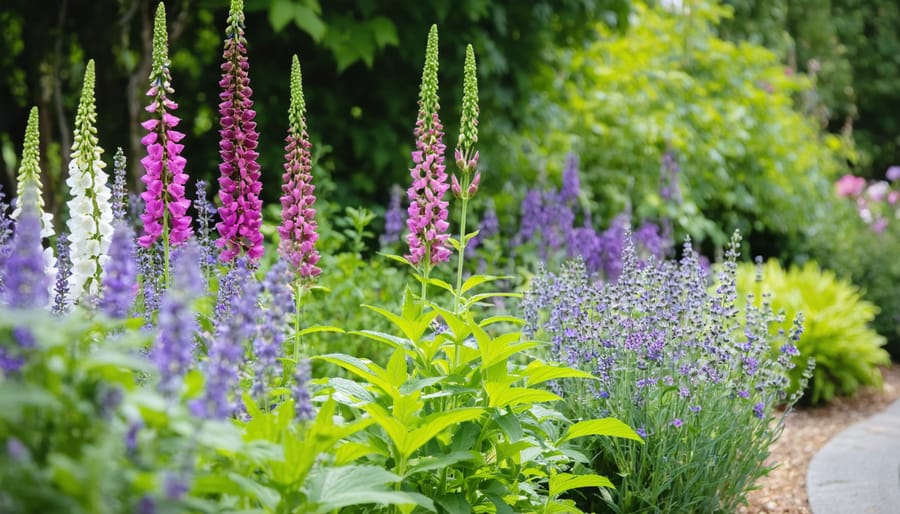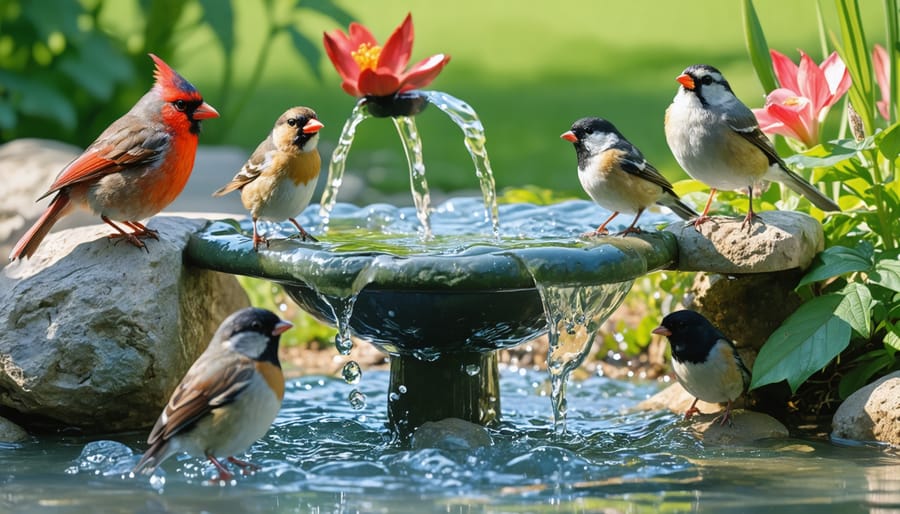Transform your garden into a balanced ecosystem by creating harmony with wildlife through strategic management techniques. Install motion-activated sprinklers to gently deter larger animals while preserving their natural patterns. Plant sacrificial borders of deer-resistant flowers like lavender and foxglove to protect valuable inner garden areas. Create dedicated wildlife corridors using native plants that provide food and shelter, directing animal movement away from sensitive growing zones. Modern wildlife management blends scientific understanding with practical solutions, allowing gardeners to maintain thriving spaces while supporting local biodiversity. These techniques work together to establish clear boundaries that respect both your gardening goals and the needs of local wildlife populations, ensuring a sustainable approach to garden stewardship.
Smart Deer Management That Protects Your Plants
Natural Barrier Plants Deer Actually Avoid
When it comes to balancing wildlife and garden needs, certain plants naturally deter deer while adding beauty to your landscape. Lavender is a fantastic choice, offering both fragrant blooms and natural deer resistance. Its strong scent keeps deer at bay, while attracting beneficial pollinators to your garden.
Russian Sage and Yarrow are two more stunning options that deer tend to avoid. These drought-tolerant perennials provide beautiful purple and multicolored blooms respectively, while their strong aromas naturally repel hungry deer.
For shady areas, try Bleeding Hearts or Foxglove. These classic garden favorites are not only visually striking but also naturally deer-resistant due to their toxic properties. Remember, while toxic to deer, these plants should also be handled with care around children and pets.
Herbs like sage, rosemary, and oregano pull double duty – they’re wonderful for cooking and naturally deer-resistant. Plant them along garden borders or pathways where deer typically enter your yard.
For year-round protection, consider incorporating boxwood or barberry shrubs. These evergreen options provide structure to your garden and create effective natural barriers that deer prefer to avoid. As a bonus, many of these plants are also drought-tolerant and low-maintenance, making them perfect for busy gardeners.
Physical Barriers That Look Good in Your Garden
Creating beautiful barriers that keep wildlife at bay doesn’t mean turning your garden into a fortress. Decorative fencing can serve as both a practical solution and an attractive garden feature. Consider installing a wrought iron fence with ornamental finials, which adds a classic touch while preventing larger animals from entering. For a more natural look, bamboo screens or reed fencing create an eco-friendly barrier that blends seamlessly with your landscape.
Raised bed gardens can be enhanced with attractive copper mesh borders that deter burrowing animals while adding a warm, metallic gleam to your beds. These can be particularly striking when they develop a natural patina over time. For fruit trees and berries, try using decorative metal hoops or artistic branch structures to support protective netting during growing seasons.
Living barriers are another excellent option. Plant thorny but beautiful roses or flowering quince along boundaries to create natural deterrents. These not only look stunning but also provide additional habitats for beneficial insects and birds. Lattice panels covered with climbing plants like jasmine or clematis create wonderful vertical barriers that mask their protective purpose.
For vegetable gardens, consider installing decorative obelisks or artistic trellises that can support fine mesh netting. These structures add architectural interest while protecting your crops. Remember, the key is to integrate these barriers naturally into your garden design, making them look intentional rather than purely functional.
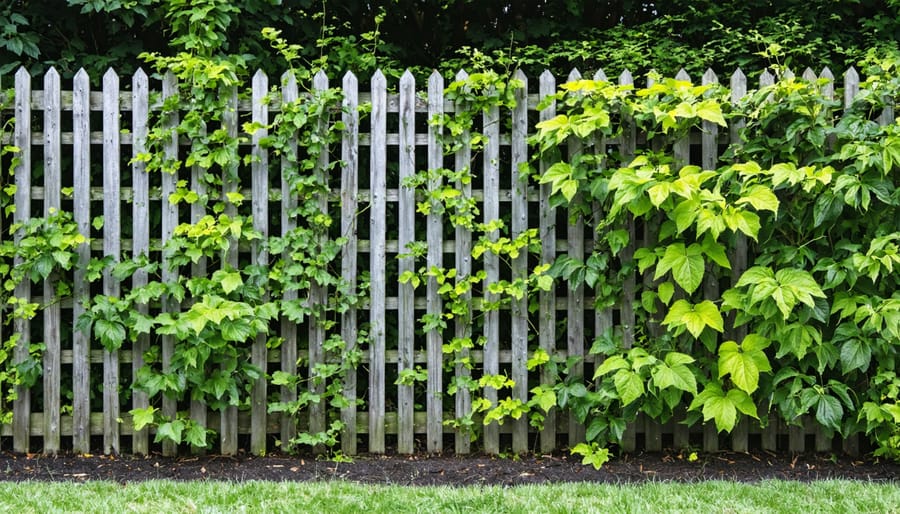
Rabbit-Proofing Without Harming Local Wildlife
Companion Planting Strategies
Creating a beautiful garden that naturally deters rabbits doesn’t mean sacrificing aesthetics. By strategically combining native garden plants with aromatic herbs and flowers, you can establish an effective barrier while enhancing your garden’s appeal.
Lavender, with its striking purple blooms and strong scent, acts as a natural rabbit deterrent while attracting beneficial pollinators. Plant it along garden borders or create decorative clusters near vulnerable plants. Sage and oregano not only add wonderful culinary value but also help keep rabbits at bay with their intense aromas.
Consider incorporating marigolds, which rabbits tend to avoid, as cheerful border plants or companion flowers among your vegetables. Their bright orange and yellow blooms add vibrant splashes of color while serving a practical purpose. Alliums, including ornamental varieties with their spectacular globe-shaped flowers, naturally repel various garden pests while creating stunning visual interest.
For additional protection, surround sensitive plants with a mix of strongly-scented herbs like mint, rosemary, and thyme. These herbs form attractive ground covers and provide fresh ingredients for your kitchen. Remember to plant these companions densely enough to create effective barriers but with adequate spacing to allow proper growth and air circulation.
This layered approach not only helps manage wildlife naturally but also creates a diverse, fragrant, and visually appealing garden space that you’ll love spending time in.
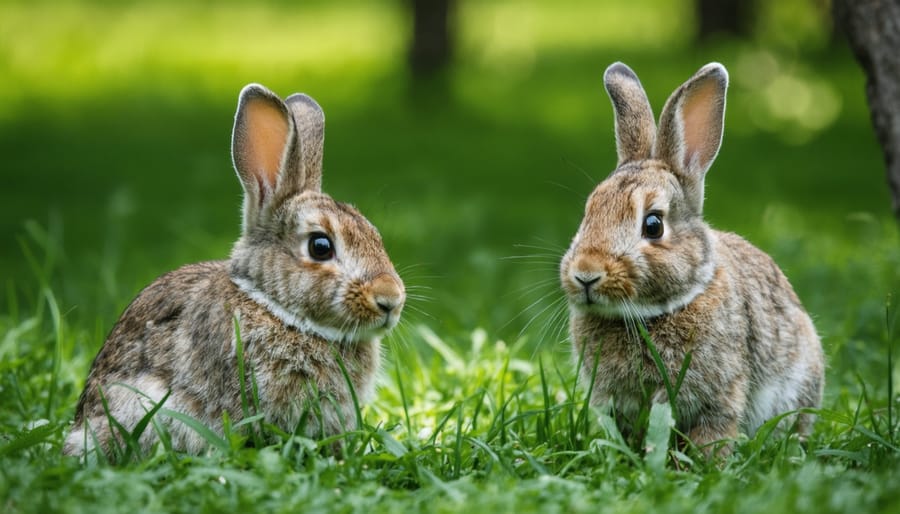
Humane Exclusion Methods
Keeping rabbits out of your garden doesn’t have to involve harmful methods. Start by installing a physical barrier like a chicken wire fence that extends at least 2 feet above ground and 6 inches below the soil to prevent burrowing. Make sure the mesh openings are no larger than 1 inch to keep even young rabbits out.
Natural repellents offer another gentle solution. Plant rabbit-resistant flowers and herbs around your garden’s perimeter, such as lavender, marigolds, and sage. These plants naturally deter rabbits while adding beauty to your space. You can also create a simple spray using garlic, hot peppers, and water to apply around your garden’s edges.
Habitat modification works wonders too. Remove dense brush, tall grass, and piles of debris near your garden, as these provide hiding spots for rabbits. Instead, maintain open spaces around your growing area, which makes rabbits feel more exposed and less likely to visit.
Motion-activated sprinklers serve as an effective and humane deterrent. When rabbits approach, they’re met with a surprising but harmless spray of water. This teaches them to avoid your garden without causing any harm. Remember to adjust the sprinkler’s sensitivity to avoid startling beneficial wildlife like birds.
For extra protection, consider raised beds with hardware cloth bottoms or decorative garden fencing that doubles as a rabbit barrier. These solutions blend seamlessly with your garden’s aesthetic while keeping your plants safe.
Bird-Friendly Solutions for Fruit Protection
Timing Your Harvest Right
Timing your harvest strategically can make a significant difference in reducing bird damage to your crops while maintaining a healthy garden ecosystem. The key is to harvest your fruits and vegetables just before they reach peak ripeness – this is when they’re most attractive to our feathered friends. For most crops, this means picking them when they’re about 80-90% ripe, allowing them to finish ripening indoors.
Early morning harvesting, just as the sun rises, offers two main advantages: first, you’ll beat the birds to their breakfast, and second, your produce will be at its freshest. For fruits like berries and tomatoes, consider harvesting them as soon as they show the first blush of color. They’ll continue to ripen on your counter while staying safe from pecking beaks.
Keep a close eye on your garden calendar, noting when different crops typically ripen. This helps you plan ahead and establish a consistent harvesting routine. For larger gardens, consider harvesting in sections rather than waiting for everything to ripen at once. This approach not only manages bird activity but also provides you with a steady supply of fresh produce.
Remember that some birds can actually help your garden by eating harmful insects, so the goal isn’t to eliminate them entirely but to find a balanced approach that protects your harvest while maintaining a wildlife-friendly space.
Bird Netting Done Right
Installing bird netting effectively is crucial for protecting your garden while ensuring the safety of our feathered friends. Start by choosing the right type of netting – look for UV-resistant, durable mesh with openings no larger than ¾ inch to prevent birds from getting tangled. Before installation, create a proper framework using sturdy poles or hoops that keep the netting elevated above your plants.
When securing the netting, ensure it’s pulled taut to prevent sagging where birds might get caught. Always leave a few inches of space between the netting and your plants to allow for growth and air circulation. Anchor the edges securely using garden stakes or clips, and bury the bottom few inches in the soil to prevent birds from finding their way underneath.
Regular maintenance is essential – check your netting weekly for tears or loose sections that could create hazards. Remove any debris that accumulates on top, and adjust the tension as needed. Remember that while netting is effective, it’s just one component of a comprehensive wildlife-friendly garden design. Consider installing the netting seasonally rather than year-round, focusing on protecting vulnerable crops during crucial growing periods.
For fruit trees, drape the netting from the canopy to the ground, creating a protective tent that still allows pollinators access during flowering. Always remove fallen fruit promptly to discourage birds from attempting to breach the barrier.
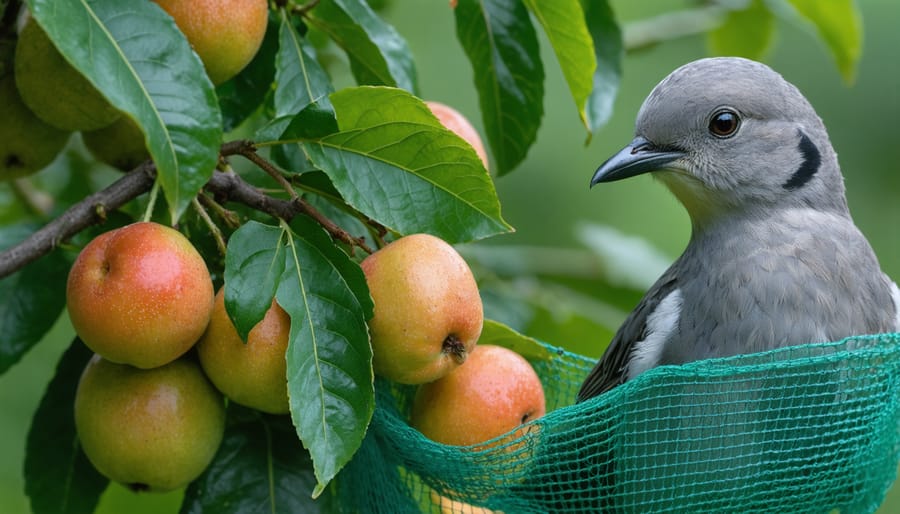
Working With Ground Animals
Underground Barriers That Last
When it comes to protecting your garden’s root systems from burrowing wildlife, underground barriers offer a long-lasting and effective solution. These barriers, often called root guards or underground fencing, create a protective shield that prevents animals from accessing and damaging your precious plants from below.
The most effective underground barriers are made from sturdy materials like galvanized metal mesh or heavy-duty plastic panels. Install these barriers at least 2 feet deep and extend them 6-12 inches above ground level to discourage persistent diggers. For best results, angle the bottom portion outward at 90 degrees to create an L-shape, which prevents animals from digging underneath.
One particularly successful approach is the “basket method,” where you create individual protective zones around valuable plants or trees. Simply dig a hole larger than your plant’s root ball, line it with mesh material, and plant within this protective cage. As your plant grows, its roots will develop safely within this barrier while being protected from voles, gophers, and other underground visitors.
Remember to choose materials that are resistant to rust and decomposition. Stainless steel or vinyl-coated wire mesh typically lasts 10-15 years, making them excellent long-term investments. While installation requires initial effort, the peace of mind knowing your plants’ root systems are protected makes it worthwhile.
For community gardens or larger areas, consider installing a comprehensive underground barrier system during the initial garden planning phase, saving time and ensuring consistent protection throughout your growing space.
Natural Deterrents That Won’t Harm Your Soil
When it comes to keeping wildlife at bay, you don’t need to resort to harsh chemicals that could harm your precious soil. Mother Nature offers plenty of effective alternatives that work wonderfully while maintaining your garden’s ecosystem. Pungent herbs like lavender, mint, and rosemary not only add beauty to your garden but naturally deter many unwanted visitors while attracting beneficial insects.
One of my favorite approaches is using companion planting with marigolds and nasturtiums around vegetable beds. These cheerful flowers naturally repel various pests while adding vibrant colors to your garden. Sprinkling coffee grounds around your plants serves multiple purposes – it deters cats and small mammals while enriching your soil with nitrogen.
For larger animals, consider creating natural barriers using thorny but beneficial plants like berry bushes. These provide you with delicious fruits while keeping deer and other browsers at a safe distance. Crushed eggshells scattered around plants deter slugs and snails while adding calcium to your soil as they decompose.
Essential oils diluted in water make excellent spray deterrents – peppermint for mice, citrus for cats, and eucalyptus for various insects. Just remember to reapply after rain. You can also try spreading human hair clippings around your garden – they’re rich in nitrogen and naturally repel deer and rabbits who associate human scent with danger.
As we’ve explored throughout this article, successful wildlife management in your garden isn’t about eliminating nature – it’s about creating harmony between your gardening goals and the local ecosystem. The key lies in understanding that each creature, from beneficial pollinators to occasional garden visitors, plays a vital role in maintaining a healthy environment.
Remember that the most effective approach combines multiple strategies: physical barriers where necessary, companion planting for natural deterrence, and creating alternative habitats that direct wildlife away from your precious plants. By implementing these methods thoughtfully, you can protect your garden while still supporting local wildlife populations.
The success stories we’ve shared demonstrate that patience and observation are your best tools. Start small, monitor what works in your specific situation, and adjust your approach as needed. Many gardeners find that what began as a challenge became an opportunity to learn more about local wildlife and create a more resilient garden.
Looking ahead, consider how your garden can become a model of sustainable wildlife management. Perhaps you’ll inspire neighbors to adopt similar practices, creating a larger wildlife-friendly corridor in your community. With thoughtful planning and the right balance of preventive measures, you can cultivate a thriving garden that coexists beautifully with local wildlife.
Remember, every garden is unique, and finding the right balance may take time. Stay patient, remain observant, and celebrate the small victories as you work toward your perfect garden ecosystem.

